The Growth Loop Playbook Top Startups Actually Use
Learn how high-growth startups engineer compounding growth using self-reinforcing systems.
Why Growth Isn’t About Funnels Anymore
Startup growth used to be all about the funnel. Awareness at the top, conversion at the bottom, and a lot of drop-off in between. It was tidy, measurable—and increasingly broken.
Funnels were built for a world where attention was cheap and paid acquisition scaled fast. But that world is gone.
CAC is rising across the board. Consumers ignore ads. Privacy changes have wrecked targeting. Even the best-optimized funnels now leak like sieves.
But the real problem runs deeper…
Brought to you by Delve:
Cut out the 60 hours of compliance busywork
You need a simple UX, clear pricing, and 1:1 Slack support. You need Delve.
Join Lovable and 100s of other companies using Delve for all things compliance (SOC 2, ISO, pentesting, and more).
And yes, this is the same Delve that went viral for sending out custom doormats.
Book a demo today with code VCCORNER for a CUSTOM DOORMAT + $1,000 OFF when you get compliant.
Funnels treat growth as a one-way push: get a user in, hope they convert, and repeat. There’s no reinforcement. No compounding. Just burn and churn.
Growth loops change that.
Loops turn user actions into new user growth—sharing, inviting, creating value that draws others in. Each cycle fuels the next. It’s not a funnel. It’s a flywheel.
Funnels get you started. Loops keep you going. Let’s dive in.
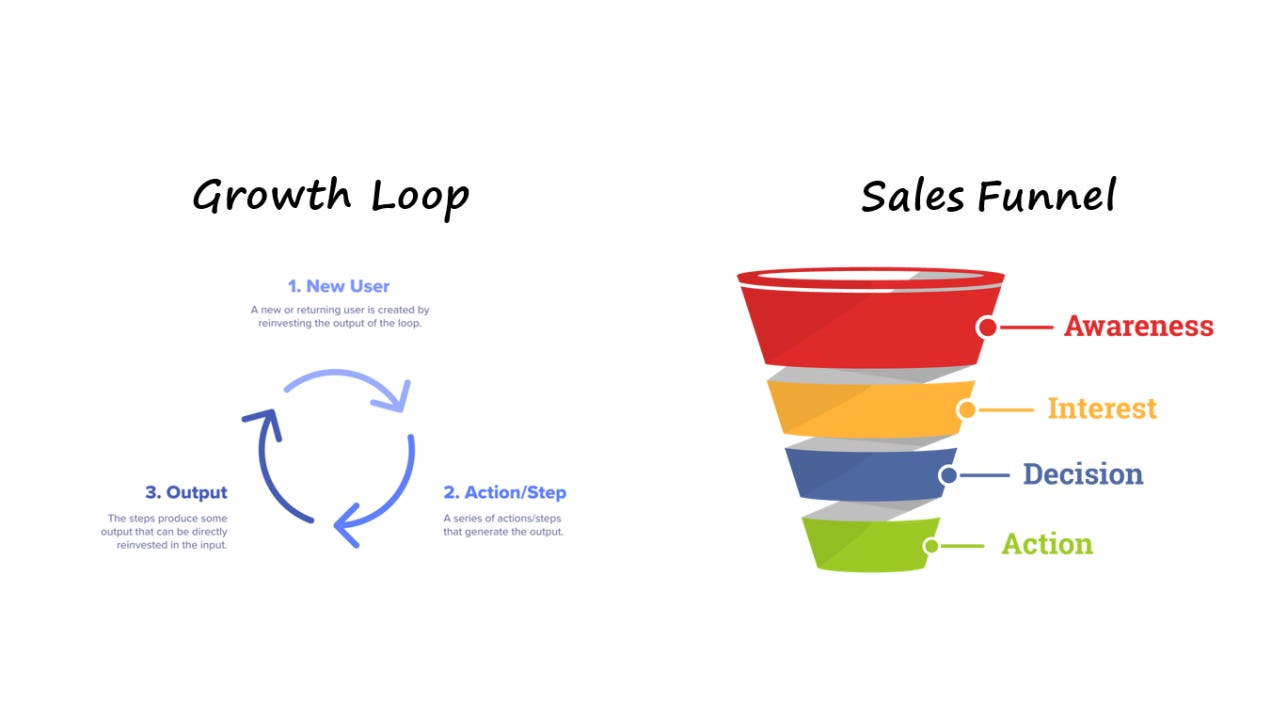
Table of Contents
What Growth Loops Actually Are
Growth Loops vs. Funnels
Why Growth Loops Matter Now
The Seven Growth Loop Archetypes (and Their Playbooks)
Real-World Growth Loop Case Studies
Build a Minimum Viable Loop
Measuring What Matters in Loops
Stop Pouring, Start Spinning
1. What Growth Loops Actually Are
A growth loop is a self-reinforcing system. One user takes an action that creates an output - content, an invite, a signal - that directly contributes to the conditions for another user to take that same action. The loop feeds itself. And the more it spins, the more efficient it becomes.
In practical terms, a growth loop starts with behavior, results in value, and uses that value to drive more behavior. Think of it as an engineered cycle:
Action → Output → Exposure → New Action. Repeat.
This is where many people confuse loops with virality or network effects. Virality is about spread: users telling other users. Network effects are about utility, products becoming more valuable as more people join. Loops can include both, but they go further. A loop isn’t just about growth happening; it’s about the product being intentionally built to trigger the next user through the last user’s actions.

Take Loom, for example. A user records a video and sends it to someone. The recipient watches, experiences the value, and often signs up to record their own. That’s not just virality, it’s the product itself doing the selling. Each interaction fuels the next. It’s structured, repeatable, and compounding.
Strong loops are built around three things:
Behavior – What the user naturally does
Motivation – Why they do it
Value Creation – What output gets created, and how it attracts or activates the next user
When these elements align, you get a loop that doesn't need constant input. It just spins.
2. Growth Loops vs. Funnels
To understand growth loops, you have to change how you think about growth itself.
Most startups still rely on funnels. The funnel offers a way to track performance and optimize each stage, but it’s a linear system. You feed users in. Some convert. Most don’t. And the moment you stop pushing traffic, the whole system stalls.
Funnels are great for short-term performance marketing. But they’re leak-prone by design. Each user passes through once. There’s no structural incentive for them to come back, bring others, or generate momentum.
Loops flip that model.
Where funnels are linear and finite, growth loops are circular and compounding. They don’t just convert users, they harness them. A user takes an action, generates value (an invite, a piece of content, a new data point), and that value helps attract or activate the next user. One person creates the conditions for another. That’s the loop. It keeps spinning as long as users keep engaging.
Here’s the shift in mindset:

Funnels = push. You spend to acquire.
Loops = pull. Users help drive more users.
The funnel is still useful for diagnosing drop-offs, optimizing onboarding, or measuring campaign ROI. But it doesn’t scale on its own. Loops do. They generate compounding returns over time, not one-off wins.
Funnels convert users. Loops create engines.
Most high-growth startups don’t abandon funnels; they build loops that make funnels unnecessary at scale.
3. Why Growth Loops Matter Now
The startup playbook that dominated the 2010s is breaking down. The old formula - raise big, spend bigger, scale fastest - no longer guarantees success.
We’re living in a post-PLG, high-CAC world. Paid acquisition is saturated. Privacy changes have made targeting harder. Organic channels are noisy. Even great products struggle to break through. Founders are discovering the hard truth: you can’t spend your way to scale anymore.
The companies that are still growing fast aren’t running bigger campaigns. They’re building smarter systems.
That’s why growth loops matter now. Loops give startups leverage. They create compounding returns where every user helps generate the next. They reduce dependency on paid acquisition. And they’re defensible, because the loop itself becomes part of your moat.
Just look at what’s working:
ChatGPT used viral content sharing and user-created GPTs to build not just buzz, but structural momentum. Every share, every public GPT became an entry point for new users.
Substack turned readers into writers, who became magnets for more readers. The loop didn’t just acquire users, it built a self-expanding ecosystem.
TikTok embedded its loop in the content experience. Watch, engage, create, repeat. The more users played, the more creators emerged, the better the content got, and the more users showed up.
These aren’t hacks. They’re designed systems where growth is the byproduct of usage.
Loops scale differently. They don’t spike. They compound. You don’t grow linearly - you grow like a flywheel picking up speed. Funnels flatten over time. Loops get stronger the longer they run.
In today’s market, that matters more than ever. Startups with loops don’t just survive tightening budgets and tougher channels, they thrive in them.
Growth loops aren’t a tactic. They’re architecture.
4. The Seven Growth Loop Archetypes (and Their Playbooks)
Not all loops are created equal. The best ones don’t just move numbers, they fit the product, match user behavior, and reinforce core value.
What follows are seven archetypes of growth loops that top startups use to engineer compounding growth. Each has its own strengths, ideal product fit, and risks. Great companies often stack multiple loops. But they always master one first.
1. The Viral Loop
Best for: Content-driven apps, consumer tools, social-first products
Example: TikTok, Spotify
In a viral loop, users bring in other users, directly or indirectly. The classic version is a user sharing content, which exposes the product to new people who sign up, engage, and share again.
TikTok is the masterclass. A creator posts a video. That video gets shared outside the app - on Instagram, Twitter, or in group chats. Someone clicks, watches, and gets pulled into the feed. Once hooked, they don’t just watch, they create. Each video becomes both entertainment and distribution. TikTok engineered this with low-friction creation (templates, filters, trending sounds) and an algorithm that rewards reach. One user’s output brings in five more.

Spotify does this more passively. Think of the “Wrapped” campaign. Users share their yearly listening stats, sparking curiosity and FOMO in their friends, who then download the app to get their own. It’s not incentivized, but it taps into identity and social proof.
Key metrics: Share rate, viral coefficient (K-factor), activation of referred users
Common pitfall: Forcing virality where it doesn’t belong. Not every product should be shared. Make sure the value is worth passing on.
2. The Referral Loop
Best for: Fintech, SaaS, marketplaces, transactional apps
Example: Dropbox, Revolut
Referral loops are explicit and incentive-driven. A user is rewarded for bringing in others via credits, cash, or product perks. Done right, it’s a loop that turns users into a scalable acquisition channel.
Dropbox’s famous loop gave extra storage to both the inviter and invitee. It worked because the reward was embedded in the product’s value (more storage = more utility), and because the process was as simple as it gets. You could invite friends from within the app in seconds. Each successful referral created two happier users who could invite others.

Revolut used a similar model but leaned into cash rewards and urgency. Refer five friends in five days, get $50. For a finance app targeting young, deal-hungry users, it was a perfect match. They layered this with notification nudges, invite tracking, and frictionless onboarding.
Key metrics: Referral rate, invite-to-activation rate, cost per referral
Common pitfall: Misaligned incentives. Cash-only referrals often attract low-quality users unless the core product value supports retention.
3. The Usage-Based Loop
Best for: Tools that generate something shareable or interactive by default
Example: Calendly, Loom
In a usage-based loop, the product becomes its own growth engine. Every time someone uses it, they naturally expose others to its value. No ads or outreach required.
Calendly nails this. A user sends a scheduling link to book a meeting. The recipient clicks, experiences this seamless booking flow, and immediately thinks: “Why am I still going back and forth on email?” One scheduling link turns into exposure. If the recipient books, the loop completes. If they sign up and send their own link, it spins again.
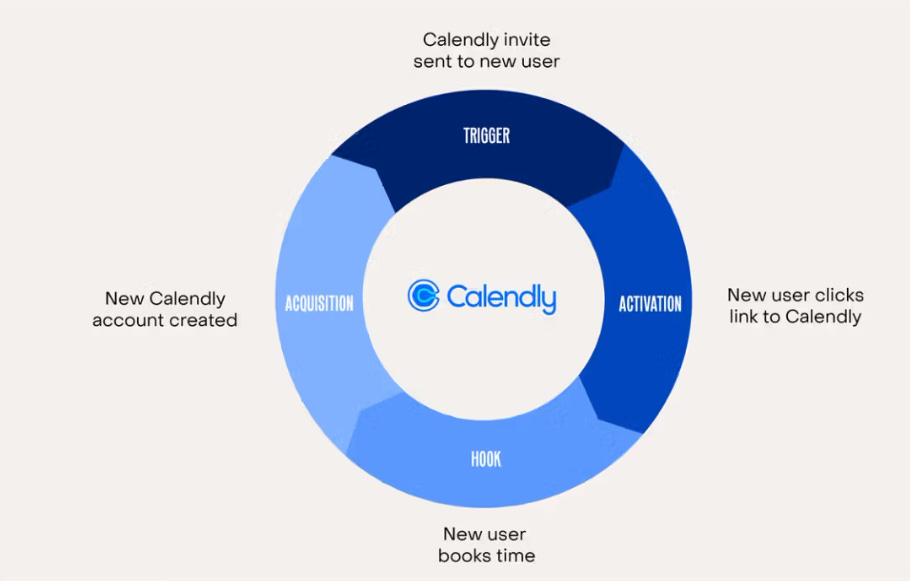
It’s effortless, embedded into daily workflows, and visible by design. Calendly grows not because people talk about it, but because they use it, and usage invites more usage.
Key metrics: External exposure (link clicks by non-users), recipient-to-user conversion rate, meeting creation frequency
Common pitfall: Assuming virality just because it’s shareable. If the recipient doesn’t instantly get the value or sees friction, the loop never completes. Track downstream activation, not just exposure.
4. The User-Generated Content (UGC) Loop
Best for: Communities, marketplaces, platforms with SEO potential
Example: Reddit, Substack, Quora, Tripadvisor
This loop creates growth through content. Users post questions, reviews, or articles. Those attract new visitors who engage with them and often contribute themselves.
Reddit’s structure is built for this. Communities grow as users post and comment, drawing in like-minded readers who then participate. That content ranks on Google and draws in search traffic. Many of those visitors become posters themselves, and the loop spins.

Substack creates a writer-to-reader-to-writer loop. Newsletters attract subscribers. Some readers are inspired to launch their own, further growing the ecosystem.
Tripadvisor scaled this beautifully. Travelers left reviews, which ranked high in search. That brought new users, who left more reviews, expanding reach via SEO in a compounding loop.
Key metrics: Content creation rate, SEO traffic growth, contributor conversion rate
Common pitfall: Expecting content to emerge organically. Seeding, incentives, and community scaffolding are often necessary early on.
5. The Collaboration Loop
Best for: Team tools, productivity software, B2B SaaS
Example: Figma, Notion, Miro
This loop activates through teamwork. One person adopts the tool and invites collaborators to get work done together. Each invite brings new users into the product environment, who then start using it independently, or invite others.
Figma’s multiplayer design made this inevitable. Designers invited PMs, engineers, and clients into a live canvas. Everyone saw the value instantly. It wasn’t just collaborative, it was contagious.
Notion took a similar route. A founder builds an internal wiki, invites team members to contribute, and soon the whole company is in. Then someone spins up a personal workspace. The loop isn’t just additive, it deepens product engagement while expanding the user base.

Key metrics: Invite rate, team activation rate, workspace proliferation
Common pitfall: Friction for new collaborators. If joining feels like a chore, the loop loses steam.
6. The Sales-Led Growth Loop
Best for: Enterprise SaaS, complex B2B products, high ACV tools
Example: Salesforce, SAP, HubSpot (mid-market and up)
This loop reinvests revenue into sales capacity. New deals drive revenue, which funds hiring more reps, who close more deals. It’s a loop of capital, headcount, and output.
Salesforce mastered this. Every dollar closed wasn’t just profit, it fueled more territory expansion. The sales team became a compounding engine.
HubSpot layered in content marketing and product tools, but sales was always at the center of the loop.

The key is that each sale creates a stronger sales machine. Pipeline visibility improves. Brand trust compounds. And wins beget more wins in the form of case studies, integrations, and customer referrals.
Key metrics: Sales velocity, CAC/LTV, rep productivity
Common pitfall: Scaling sales before product-market fit. This loop only works when the core value is already validated.
7. The Product-Led Growth (PLG) Loop
Best for: Self-serve SaaS, freemium products, bottoms-up adoption
Example: Slack, Notion, ChatGPT, Zoom
This loop is about designing the product to drive its own adoption. Users sign up, see value quickly, and naturally expand usage, often team-wide or org-wide, without needing a sales push.
Slack is a textbook product-led loop. One team signs up. They start chatting. It clicks. Other teams get pulled in. Before long, it’s the default communication tool. No sales pitch required.
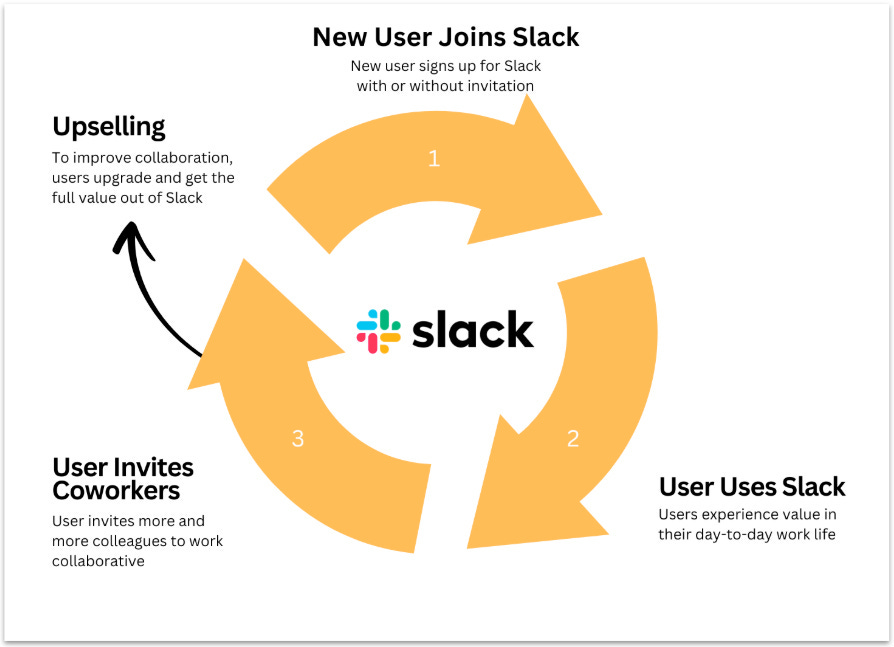
ChatGPT scaled the loop further. People shared outputs online. Others joined to try it. Then came Custom GPTs, which users created and shared, driving discovery, usage, and retention.
Key metrics: Activation rate, expansion rate (users/org), time-to-value
Common pitfall: Mistaking sign-ups for adoption. PLG loops only work when the value is delivered early and often.
Loops aren’t features. They’re systems.
The best growth teams don’t ask, “How do we acquire more users?” They ask, “What user actions naturally generate more value, and how do we amplify them?”
Pick the loop that fits your product’s DNA. Design around real behavior. Then test, tighten, and scale.
5. Real-World Growth Loop Case Studies
The theory of growth loops is simple. The execution is not.
Loops look obvious in hindsight. But in practice, they emerge through deliberate design, fast iteration, and a deep understanding of user behavior. Great companies don’t just have loops, they engineer them into the product, the experience, and the business model itself.
Let’s break down five standout companies that built enduring, compounding loops and why their playbooks are still misunderstood.
1. Substack: The Creator-Reader Loop
Substack didn’t grow by chasing creators. It grew by building a loop between writers and readers that fueled itself from both sides.
When a writer launches on Substack, they bring their existing audience. Some of those readers become subscribers, free or paid. But here’s the magic: readers often become writers themselves. Substack actively encouraged this by lowering publishing friction, highlighting popular writers, and embedding subtle nudges like “Start a publication” links in every inbox.
That content brings in more readers. Some of them turn into writers. And the flywheel spins.

Later, Substack reinforced the loop with discovery tools, category pages, and a referral program where writers could share audiences. The network started compounding, not just user-by-user, but community-by-community.
Loop: Writer → Content → Readers → New Writers → More Content
Loop drivers: Creator conversion rate, reader growth from shares, writer-to-writer referrals
Why copycats fail: Most platforms assume creators are loyal. Substack succeeded by offering direct ownership (email list control, monetization) and simplicity. Most competitors miss that motivation.
2. Twitch: The Streamer-Viewer Monetization Loop
Twitch’s loop wasn’t just social, it was economic.
Streamers broadcast. Viewers watch, chat, subscribe, donate, and engage. That engagement generates income for the streamer and visibility on the platform. Higher earnings → more incentive to stream → better content → more viewers.
Twitch also invested heavily in creator tooling, such as chat moderation, loyalty badges, overlays, and sponsorship opportunities. It created a system where every viewer’s interaction had potential monetary or emotional value. The loop became sticky.

Over time, viewers didn’t just consume, they became streamers. The barrier to entry was low (OBS, webcam, mic), and Twitch culture made creators feel part of something. That shift supercharged the ecosystem.
Loop: Streamer → Content → Viewers → Engagement → Income + Social Proof → More Streamers
Loop drivers: Concurrent viewership, average revenue per streamer, streamer churn
Why copycats fail: Many platforms launch creator programs without audience liquidity. Twitch seeded both sides early and kept the monetization loop tight.
3. ChatGPT: The Multi-Loop Momentum Engine
ChatGPT’s growth wasn’t viral by accident. It was multi-loop by design.
At first, users shared screenshots of quirky or brilliant AI responses. OpenAI noticed this and quickly added a Share button in the interface, turning passive exposure into intentional distribution. The loop - users generated content → shared it → drew in new users who then generated their own content.

Then came Custom GPTs: user-built bots with their own names, profiles, and use cases. OpenAI created a searchable directory (GPT Store), added SEO-friendly pages, and let these GPTs be indexed. Users became distribution nodes, not just consumers.
Finally, session history and pinned chats improved retention and encouraged reuse. The more you used it, the more useful it became. The loops weren’t just external, they ran deep inside the product.
Loops:
Prompt → Response → Share → New User → Prompt
User builds GPT → Indexed Page → Search Traffic → New User → Builds GPT
Session → Saved History → Reuse → Habit → More Prompts
Loop drivers: Share rate, GPT creations, search-driven signups, retention
Why copycats fail: They focus on the AI, not the system. OpenAI layered usage, creation, and distribution into loops, not just features.
4. Tripadvisor: The SEO-Driven UGC Flywheel
Tripadvisor is a case study in patient, long-term loop building.
At its core, Tripadvisor’s loop is simple: travelers leave reviews. Those reviews show up in search results for destinations, hotels, and experiences. New travelers click, read, and leave their own reviews. The loop strengthens with every contribution.
What made it scale was Tripadvisor’s SEO execution. It built structured pages, optimized for long-tail travel keywords, and surfaced UGC in a way that search engines loved. Over time, its UGC moat made it nearly impossible to compete on travel queries.

The loop didn’t stop at content. Tripadvisor also closed the loop by building email capture, review reminders, and integrations with booking flows that nudged every traveler to contribute after every trip.
Loop: Traveler → Review → Search Visibility → New Traveler → Review
Loop drivers: Reviews per listing, SEO traffic growth, conversion of searchers to contributors
Why copycats fail: They expect fast UGC. Tripadvisor took years to hit velocity, with relentless optimization.
5. Perplexity: Platform-Aware Growth Stack
Perplexity AI didn’t just build an AI search engine. It built growth into every interaction.
On social media, users can tag @AskPerplexity on X (Twitter) to get AI-powered answers in public threads. Each interaction is self-exposing: one user asks, thousands see. That curiosity drives clicks and new users.
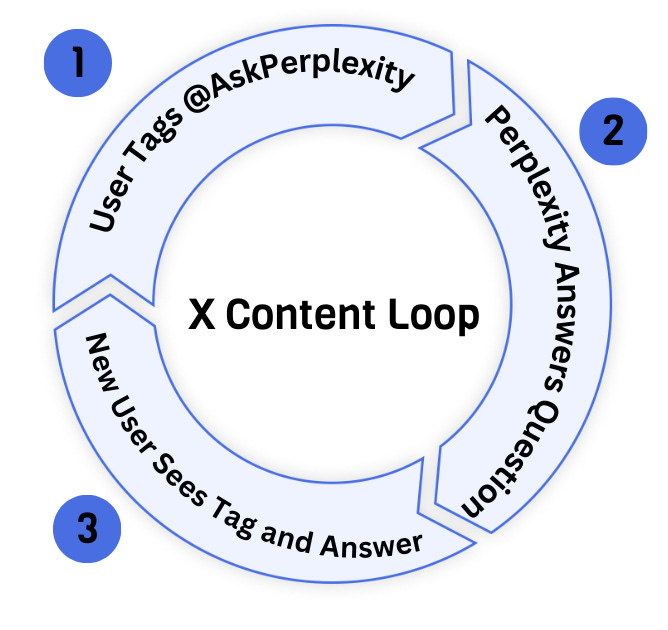
Beyond social, Perplexity integrated Pages and Spaces. These are shareable, indexable Q&A artifacts created by users. Each page becomes content that drives SEO, inviting new users into the platform. The more questions people ask and publish, the richer the search surface becomes.
Perplexity also created a habit loop by positioning itself as the default search engine for power users, subtly driving retention through default behavior.
Loops:
Social Q&A → Thread Visibility → Clicks → New User → More Social Q&A
Published Answer → SEO Traffic → Signup → More Answers
Search Habit → Daily Use → Reinforcement
Loop drivers: Social impressions, indexed answers, returning user rate
Why copycats fail: They focus on features, not touchpoints. Perplexity inserted itself where users already are, then built loops around that context.
These companies didn’t grow because they got lucky. They grew because they understood the mechanics of compounding, and built systems where each user and each action made the next one more likely.
The best growth loops feel inevitable in hindsight. That’s what makes them powerful, and difficult to copy without understanding why they work.
6. Build a Minimum Viable Loop
Understanding loops is one thing. Building one is something else entirely.
This is where most startups get stuck, not because loops are hard to understand, but because they try to build the final version on day one. Don’t.
The most effective loops don’t start as polished systems. They begin as scrappy prototypes rooted in user behavior that’s already happening. The goal at this stage isn’t scale. It’s motion.
A Minimum Viable Loop (MVL) is exactly that - a small, testable version of a loop that lets you observe whether self-reinforcing behavior exists, and whether you can nudge it forward.
Start With What Users Already Do
Before building anything, zoom in on what your users are already doing naturally. Are they sharing your product without being asked? Sending invites? Creating something others engage with? Referring friends through screenshots or DMs?
That’s your raw material. Loops aren't invented. They're designed around real behaviors with real motivations. Your job is to spot the ember and gently fan it into a flame.
If no reinforcing behavior exists yet, you may have a product-market fit issue instead of a loop issue.
Design the Flow, Not the Feature
A growth loop isn’t a single button or widget. It’s a flow of value that travels from one user to the next.
Map it out:
Trigger – What starts the loop?
Output – What is created (a share, a piece of content, an invite)?
Exposure – How does that output reach a new user?
Reinforcement – What motivates the next user to take the same action?
Keep it simple. If you can’t sketch it in four steps, it’s probably too complicated to test.
Example:
Let’s say you run a journaling app. You notice users screenshot entries and post them to Instagram. That’s your spark.
Your MVL might look like: Write Entry → Auto-format + Share Button → Story Tag → New User Clicks → Installs + Writes Entry
No referral codes. No incentives. Just a lightweight feature that turns private value into public exposure.
That’s a loop. It starts with behavior, delivers value, and creates exposure to new users who repeat the same behavior.
Build It Ugly. Test It Fast.
MVLs don’t need to scale. They just need to spin.
Hardcode things if you have to. Manually onboard users. Use off-the-shelf tools or scripts. Watch the loop run in slow motion, with real people.
If the loop works, you’ll notice a compounding effect. A few users create value, that value draws in a few more, and the cycle repeats. If it doesn’t, great. Now you know where it’s breaking. Friction? Motivation? Weak output?
Tweak one part and test again.
Keep It Tight and Natural
The tighter the loop, the faster it compounds. Don’t build a loop that takes 30 days to complete. Aim for 30 minutes, or even 30 seconds. Fast feedback accelerates both growth and learning.
And don’t try to coerce unnatural behavior. Loops work when they align with how people already use your product. If you're forcing it, users won’t play along. The best loops feel inevitable, like you're just removing friction from what users already want to do.
Your First Loop Won’t Be Perfect. That’s the Point.
You’ll probably ship a half-baked version. That’s fine. Loops aren’t magic, they’re mechanical. You optimize each step until the whole thing starts spinning faster. Then, and only then, do you scale it.
What matters is getting one turn of the wheel. From there, it gets easier.
7. Measuring What Matters in Loops
A loop that isn’t measured is just a guess.
To build compounding growth, you need to know if your loop is actually spinning and where it’s slowing down. That means tracking the right metrics, not just the obvious ones.
Here are five core metrics every loop operator should watch. Together, they paint a picture of loop health, not just user behavior.
Viral Coefficient (K-Factor)
This is the classic measure: how many new users does each user bring in?
A K > 1 means your user base is growing exponentially. A K < 1 means it’s shrinking, or dependent on outside inputs.
But nuance matters. Most loops won’t sustain a pure K > 1. What you’re really watching is whether each loop cycle reliably creates new growth. Calendly, for instance, doesn’t need every user to convert a new one daily, but over time, most do through repeated link sharing.
Track this by measuring:
Invites sent per user
Acceptance/conversion rate
Time-to-conversion for invitees
If your K is flatlining, the loop isn’t pulling. Fix the friction.
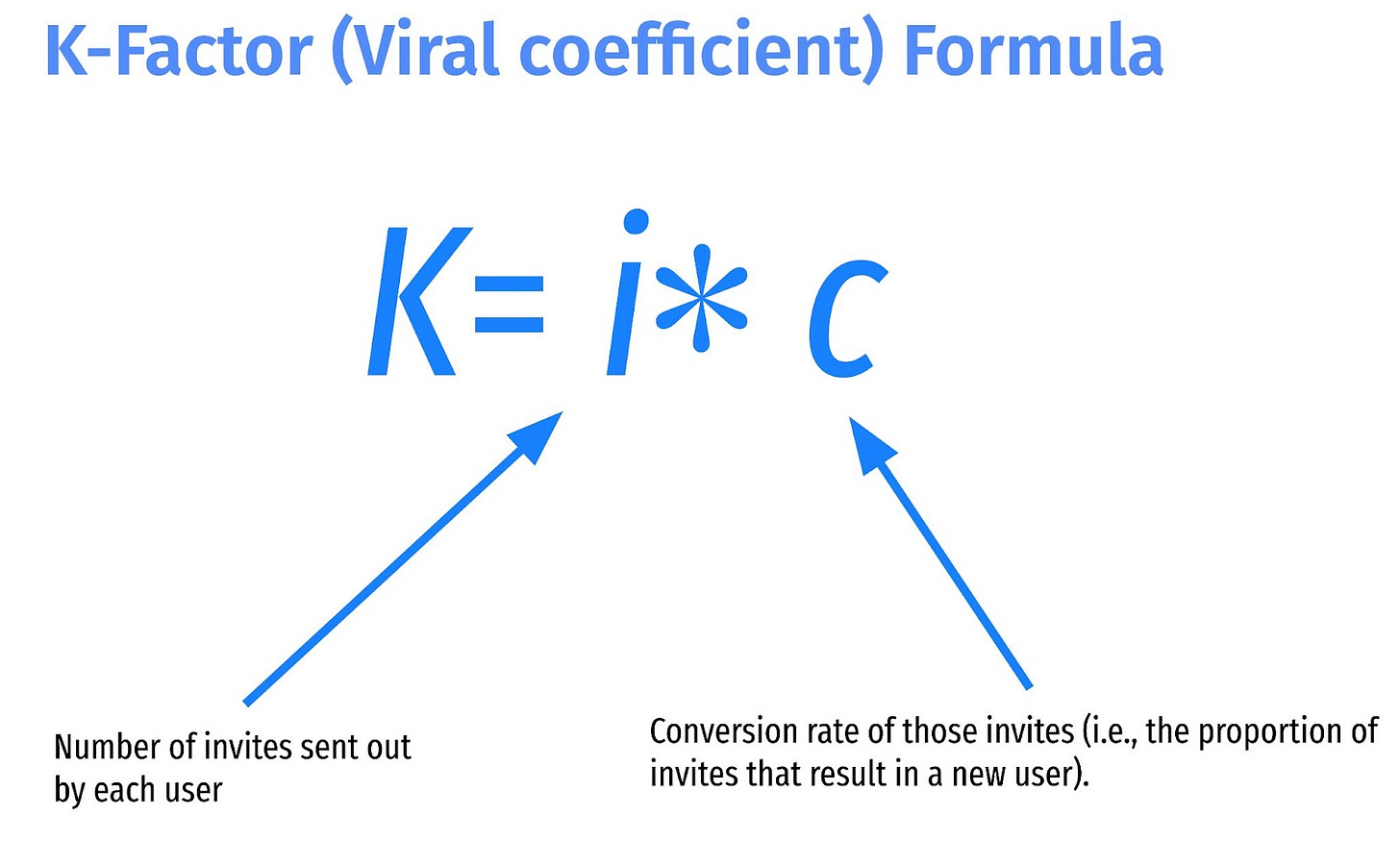
Loop Velocity (Cycle Time)
How long does it take for a user to complete the loop?
A great loop doesn’t just convert; it converts quickly. If it takes two weeks for someone to create content, share it, and attract a new user, that’s a slow wheel. Faster loops compound quicker.
Track:
Time between user sign-up and first output (e.g. share, invite, contribution)
Time from one loop cycle to the next
Tighten the loop by removing steps, prompting earlier actions, and streamlining exposure. Speed amplifies compounding.
Drop-Off Rate (Loop Friction Points)
Every loop has weak spots. Measuring drop-off means identifying where users start, but don’t finish the loop.
Look at:
% of users who initiate but don’t complete the loop (e.g. click “invite” but don’t send it)
% who complete the action but don’t trigger the next user (e.g. video shared but not viewed)
This is where loop diagnostics come in. Your job is to trace the flow:
Where are users stalling?
Is the motivation strong enough?
Is the output compelling or easy to ignore?
Use session replays, in-app surveys, and micro-funnel breakpoints to get specific. Don’t just analyze acquisition. Diagnose the loop itself.
Retention and Loop Recurrence
Loops thrive on stickiness. The longer users stay, the more chances they have to complete the loop again, and again.
Track:
Day 1 / Day 7 / Day 30 retention for users who engaged with the loop
% of users who complete the loop more than once
This tells you whether your loop has depth or just novelty. If users participate once and bounce, the loop isn’t sustainable.
Recurrence compounds impact. Each user has multiple shots at triggering the loop.
Reinvestment Rate (if applicable)
In loops that involve resource input, like ad spend or sales teams, you need to know how much of the output is being reinvested into the next cycle.
Ask: What percentage of what we generate (revenue, time, user actions) goes back into driving the loop forward?
In a sales-led loop for example, that path might look like:
New revenue → more reps → more deals.
If the reinvestment rate is too low, the loop stalls. If it’s too high, the loop burns resources. The goal is efficiency, not just growth.
Loop Diagnostics: Thinking Like a Systems Engineer
When a loop isn’t delivering, don’t guess. Diagnose.
Is the input happening? (Are users taking the first action?)
Is the output valuable? (Does it generate visibility, engagement, or conversions?)
Is the loop tight enough? (Does the next user act, or just lurk?)
Is the cycle repeatable? (Can users go again, or is it a one-time event?)
This mindset is what separates growth hacking from loop design. You’re not optimizing surface metrics. You’re troubleshooting a system.
Tools To Use
Use Mixpanel, Amplitude, or GA4 to track event sequences and cohort flows. But the tools don’t matter if your instrumentation is shallow.
Build dashboards around:
First action taken
Loop completion
Time to next action
Exposure from output
Conversion from output
Treat your loop like a machine. Watch it run. When it stalls, don’t panic, inspect the gears.
8. Stop Pouring, Start Spinning
Most startups spend their early years pouring water into a leaky funnel, campaign after campaign, channel after channel, always needing more at the top to get anything at the bottom.
But the smartest teams don’t just pour. They build.
They engineer systems where each user, each action, creates momentum for the next. They design products where growth is embedded, not bolted on. They move from hacks to loops. From churn to compounding. From push to pull.
That’s the paradigm shift.
Funnels are about acquisition. Loops are about acceleration.
So the right question isn’t “How do we get more users?”
It’s: What are our users already doing that could drive the next one? And how do we amplify that?
Stop chasing tactics. Start spinning systems.



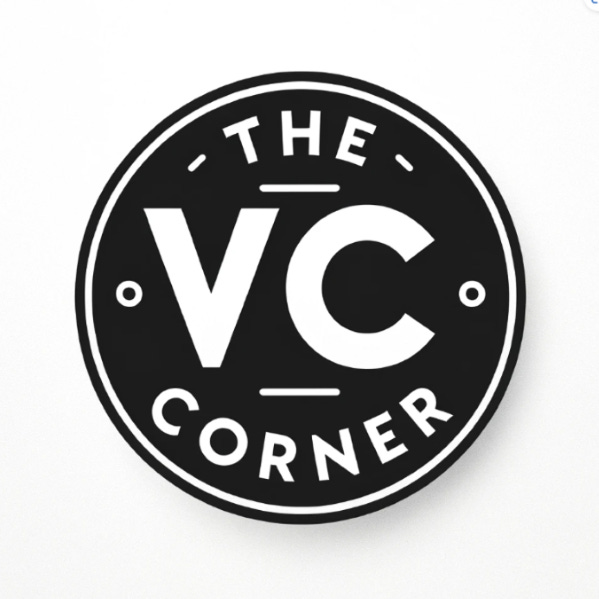
Hi Ruben. Loved this article. Practical and insightful. Our newsletters have certain overlapping topics. Mind if I feature some of your articles in my newsletter?